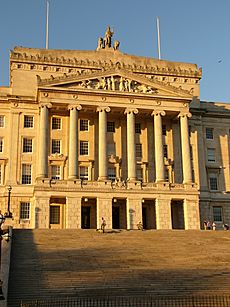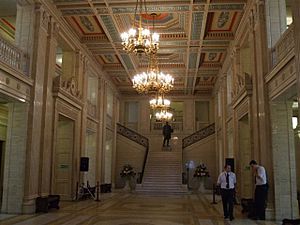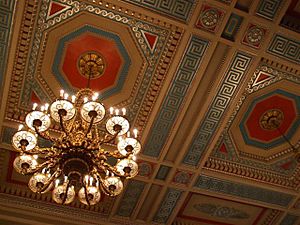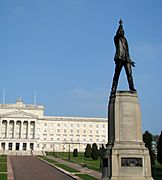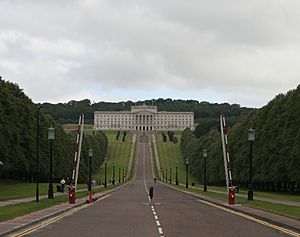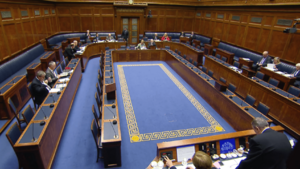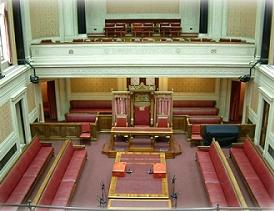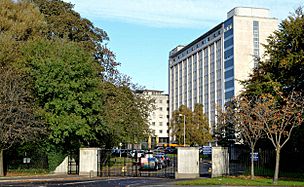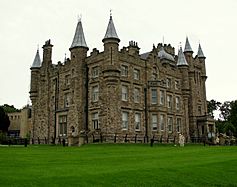Parliament Buildings (Northern Ireland) facts for kids
Quick facts for kids Parliament Buildings |
|
|---|---|
| Stormont | |
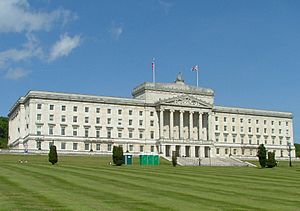 |
|
| Location | Stormont Estate, Belfast |
| Built | 1932 |
| Architect | Sir Arnold Thornely |
| Architectural style(s) | Greek classical style |
|
Listed Building – Grade A
|
|
| Official name: Parliament building, walls & lamp standards | |
| Designated | 13 March 1987 |
| Reference no. | HB26/13/013 |
The Parliament Buildings, often called Stormont, is a very important building in Belfast, Northern Ireland. It's where the Northern Ireland Assembly meets to make laws and decisions for the region. The building was specially designed by Arnold Thornely and opened in 1932 by Edward, Prince of Wales.
The government's main offices are located nearby at Stormont Castle. In 1987, the Parliament Building was officially recognized as a "Grade A Listed building." This means it's a very important historic building that needs to be protected.
Contents
History of Stormont
Building the Parliament

Northern Ireland needed its own parliament building after it was created in 1920. Before the new building was ready, the first Parliament of Northern Ireland met in two different places. One was Belfast City Hall, where King George V officially opened the first Parliament in 1921. The other was a college nearby called Assembly's College.
In 1922, a design by Sir Arnold Thornely was chosen. Work began on the chosen site, which is east of Belfast. The first plans were for a huge building with a dome and two smaller buildings on the sides. This large complex was meant to hold all parts of the government: those who make laws, those who carry them out, and the courts. This is why the official name still uses the word "Buildings" (plural).
However, these plans were too expensive. So, it was decided to build only the main Parliament Building, without the dome. The first stone was laid on May 19, 1928. The building was designed in a classical Greek style and built with strong stone. It was officially opened on November 16, 1932.
What the Finished Building Looked Like
Since the bigger plans were cancelled, the government's main offices ended up at Stormont Castle. This old house was originally supposed to be knocked down. Stormont Castle became the home of the Prime Minister of Northern Ireland. It was also where the government's main committee met. Another house, Stormont House, was the official home for the Speaker of the Parliament. The main court, the High Court, was eventually built in Belfast city centre.
The Parliament Buildings had two main rooms for debates. One was the House of Commons of Northern Ireland, which had blue benches. The other was the smaller Senate of Northern Ireland, with red benches. In the main entrance hall, now called the Great Hall, a large gold chandelier was hung. This chandelier was a gift from King George V. It had once been in Windsor Castle and was a gift from the German Kaiser Wilhelm II. The Kaiser's chandelier was put into storage during World War I and never hung in Windsor again.
A painting called The Entry of King William into Ireland was given by the Dutch Government. It was hung in the House of Commons when the building opened. But it was later removed because some people were concerned it also showed the Pope.
The building itself has not changed much over the years. During World War II, the building's white stone was painted with a dark mixture to hide it from enemy planes. This "paint" was very hard to remove after the war. It took seven years to clean, and the building's outside has never fully returned to its original white colour. You can still see some traces of the dark paint in hidden parts of the building.
Statues at Stormont
Other changes to the building and its grounds include two important statues. A statue of Edward, Lord Carson, stands dramatically on the drive leading up to the building. This statue was put up in 1932, which was unusual because it was before he passed away. Inside the Great Hall, there is a statue of Lord Craigavon. Lord Craigavon and his wife are buried in the grounds of the estate.
How the Building Has Been Used
The building was home to the Parliament of Northern Ireland until 1972. During World War II, the Senate chamber was used by the Royal Air Force (R.A.F.) as an operations room. The building was also used for a short-lived power-sharing government in 1974. From 1973 to 1998, it was the main office for the Northern Ireland Civil Service. Between 1982 and 1986, it was the meeting place for another assembly.
In the 1990s, some people suggested building a new parliament building for Northern Ireland. They felt that Stormont was too strongly linked to one political group. However, this idea was not supported by others. So, the new Northern Ireland Assembly and its government were set up in Stormont as their permanent home.
On December 3, 2005, the Great Hall was used for the funeral service of George Best. He was a famous footballer from Northern Ireland and Manchester United. The building was chosen because its grounds were the only place in Belfast big enough for the huge crowd who wanted to attend. About 25,000 people gathered in the grounds, and thousands more watched the funeral procession.
On September 29, 2012, the grounds were used for a large parade by the Orange Order. This parade remembered the signing of the Ulster Covenant. About 60,000 people filled the grounds after marching through Belfast.
The Chambers
Assembly Chamber
The original House of Commons chamber was destroyed by a fire on January 2, 1995. The fire was blamed on an electrical problem. Some people thought it might have been set on purpose. However, official reports said it was "improbable" that the fire was deliberate. The fire allowed for the creation of the modern chamber used by the power-sharing Northern Ireland Assembly. This new chamber has a horseshoe-shaped seating arrangement, which is less confrontational than the old layout.
Senate Chamber
Unlike the new Assembly chamber, the Senate chamber still looks much like it did when it opened in 1932. It has red leather seats arranged in two parallel blocks. Irish damask linen hangs on the walls. This chamber has not been used for full parliamentary meetings since 1972. Today, the Senate chamber is used as a committee room.
A few changes have been made to the chamber since 1932. Television cameras and microphones have been added. Two paintings have also been hung. One painting shows the opening of the Northern Ireland Parliament in 1921. Facing it is another painting called The House Shall Divide. This painting shows the members elected to the first Assembly in 1998.
An inscription has also been added to the marble railing of the Senate Chambers Press Gallery. It says: "This inscription records the gratitude of His Majesty's Government in the United Kingdom for the use of this chamber as an operations room by the Royal Air Force during the Second World War."
Stormont Estate
The Stormont Estate is a large area that holds Northern Ireland's main government buildings. These include the Parliament Buildings, Stormont Castle, and Stormont House.
Gallery


